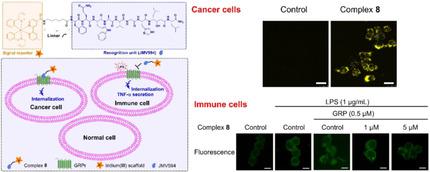当前位置:
X-MOL 学术
›
Angew. Chem. Int. Ed.
›
论文详情
Our official English website, www.x-mol.net, welcomes your
feedback! (Note: you will need to create a separate account there.)
Peptide-Conjugated Long-Lived Theranostic Imaging for Targeting GRPr in Cancer and Immune Cells.
Angewandte Chemie International Edition ( IF 16.1 ) Pub Date : 2020-07-10 , DOI: 10.1002/anie.202007920 Wanhe Wang 1 , Ke-Jia Wu 2 , Kasipandi Vellaisamy 1 , Chung-Hang Leung 2 , Dik-Lung Ma 1
Angewandte Chemie International Edition ( IF 16.1 ) Pub Date : 2020-07-10 , DOI: 10.1002/anie.202007920 Wanhe Wang 1 , Ke-Jia Wu 2 , Kasipandi Vellaisamy 1 , Chung-Hang Leung 2 , Dik-Lung Ma 1
Affiliation

|
Gastrin‐releasing peptide receptor (GRPr) plays proliferative and inflammatory roles in living systems. Here, we report a highly selective GRPr antagonist (JMV594)‐tethered iridium(III) complex for probing GRPr in living cancer cells and immune cells. This probe exhibited desirable photophysical properties and also displayed negligible cytotoxicity, overcoming the inherent toxicity of the iridium(III) complex. Its long emission lifetime enabled its luminescence signal to be readily distinguished from the interfering fluorescence of organic dyes by using a time‐resolved technique. This probe selectively visualized living cancer cells via specific binding to GRPr, while it also modulated the function of GRPr on TNF‐α secretion in immune cells. To our knowledge, this is the first peptide‐conjugated iridium(III) complex developed as a GRPr bioimaging probe and modulator of GRPr activity. This theranostic agent shows great potential at unmasking the diverse roles of GRPr in living systems.
中文翻译:

靶向癌症和免疫细胞中GRPr的肽共轭长寿治疗诊断成像。
胃泌素释放肽受体(GRPr)在生命系统中起着增生和炎性的作用。在这里,我们报道了一种高度选择性的GRPr拮抗剂(JMV594)系铱(III)复合物,用于探测活癌细胞和免疫细胞中的GRPr。该探针表现出所需的光物理性质,并且还表现出微不足道的细胞毒性,克服了铱(III)复合物的固有毒性。它的长发射寿命使它的发光信号可以通过使用时间分辨技术轻松地与有机染料的干扰荧光区分开。该探针通过与GRPr特异性结合而选择性地使活着的癌细胞可视化,同时还调节了GRPr对免疫细胞中TNF-α分泌的功能。据我们所知,这是第一个作为GRPr生物成像探针和GRPr活性调节剂开发的肽缀合铱(III)复合物。这种治疗诊断剂在揭示GRPr在生命系统中的各种作用方面显示出巨大潜力。
更新日期:2020-07-10
中文翻译:

靶向癌症和免疫细胞中GRPr的肽共轭长寿治疗诊断成像。
胃泌素释放肽受体(GRPr)在生命系统中起着增生和炎性的作用。在这里,我们报道了一种高度选择性的GRPr拮抗剂(JMV594)系铱(III)复合物,用于探测活癌细胞和免疫细胞中的GRPr。该探针表现出所需的光物理性质,并且还表现出微不足道的细胞毒性,克服了铱(III)复合物的固有毒性。它的长发射寿命使它的发光信号可以通过使用时间分辨技术轻松地与有机染料的干扰荧光区分开。该探针通过与GRPr特异性结合而选择性地使活着的癌细胞可视化,同时还调节了GRPr对免疫细胞中TNF-α分泌的功能。据我们所知,这是第一个作为GRPr生物成像探针和GRPr活性调节剂开发的肽缀合铱(III)复合物。这种治疗诊断剂在揭示GRPr在生命系统中的各种作用方面显示出巨大潜力。











































 京公网安备 11010802027423号
京公网安备 11010802027423号